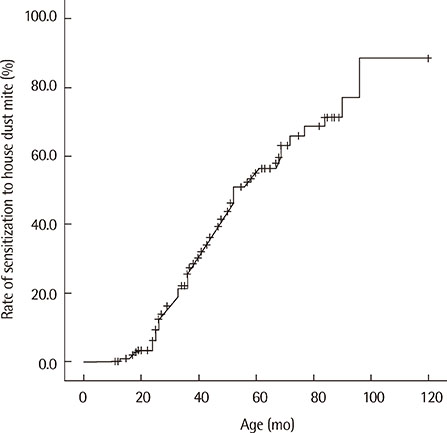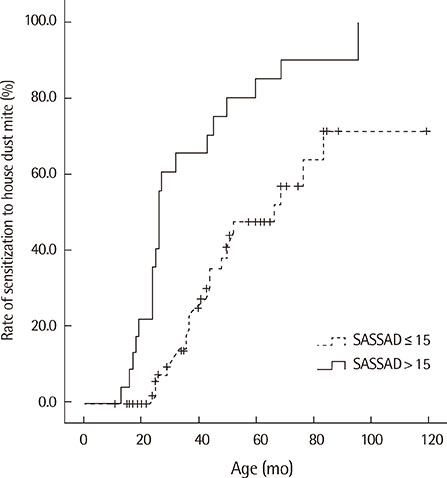Positive conversion of specific IgE against house dust mite in children with atopic dermatitis under 24 months of age
- Affiliations
-
- 1Department of Pediatrics, Samsung Medical Center, Sungkyunkwan University School of Medicine, Seoul, Korea. kmaped@skku.edu
- 2Environmental Health Center for Atopic Diseases, Samsung Medical Center, Seoul, Korea.
- KMID: 2262593
- DOI: http://doi.org/10.4168/aard.2013.1.4.350
Abstract
- PURPOSE
A considerable number of children with atopic dermatitis (AD) is known to be sensitized with respiratory allergen and developed to respiratory allergic disease. We aimed to determine the time of sensitization to house dust mite (HDM) allergen and identify the risk factors of sensitization in children with AD.
METHODS
Data from 159 children with AD aged less than 24 months and with no sensitization to HDM were analyzed retrospectively. Disease severity, total IgE, specific IgE levels to HDM and food allergens were assessed. They were followed to monitor positive conversion of specific IgE against HDM and development of allergic respiratory diseases. The specific IgE was considered as positive when its level was over 0.69 kU/L.
RESULTS
The 44.7% of children with AD were sensitized to HDM. The 50% of sensitization to HDM occurred at the median age of 52 months using survival analysis. The severity of atopic dermatitis (six area, six sign in atopic dermatitis score>15; hazard ratio, 2.62) and high peak total IgE in 2 years old (hazard ratio, 1.58) was associated with an increased risk of sensitization to HDM. Sensitization to food allergen, family history of allergic disease and total IgE of 1st visit of hospital were not associated with early sensitization to HDM.
CONCLUSION
The sensitization of HDM of children with AD occurred at the median age of 52 months. The risk factors of sensitization to HDM were AD severity and total IgE level. Children with severe AD need to control the indoor environment before 24 months of age.
MeSH Terms
Figure
Cited by 3 articles
-
House Dust Mite Sensitization Is Inversely Associated with Plasma 25-Hydroxyvitamin D3 Levels in Patients with Severe Atopic Dermatitis
Yong Hyun Jang, Hyun Bo Sim, Sun Young Moon, Weon Ju Lee, Seok-Jong Lee, Meiling Jin, Sang-Hyun Kim, Do Won Kim
Ann Dermatol. 2017;29(4):400-406. doi: 10.5021/ad.2017.29.4.400.Sensitization in children with atopic dermatitis: a single center study
Ari Song, Ji Young Lee, Hea-kyoung Yang, Minji Kim, Kangmo Ahn, Sang-il Lee, Jihyun Kim
Allergy Asthma Respir Dis. 2016;4(4):290-295. doi: 10.4168/aard.2016.4.4.290.Prevalence of atopic dermatitis and its associated factors for elementary school children in Gyeonggi-do province
Eunji Kim, Soohyun Ri, Sung Chul Seo, Ji Tae Choung, Young Yoo
Allergy Asthma Respir Dis. 2016;4(5):346-353. doi: 10.4168/aard.2016.4.5.346.
Reference
-
1. Guillet G, Guillet MH. Natural history of sensitizations in atopic dermatitis. A 3-year follow-up in 250 children: food allergy and high risk of respiratory symptoms. Arch Dermatol. 1992; 128:187–192.
Article2. Wuthrich B. Clinical aspects, epidemiology, and prognosis of atopic dermatitis. Ann Allergy Asthma Immunol. 1999; 83:464–470.
Article3. Gustafsson D, Sjoberg O, Foucard T. Development of allergies and asthma in infants and young children with atopic dermatitis: a prospective follow-up to 7 years of age. Allergy. 2000; 55:240–245.
Article4. Patrizi A, Guerrini V, Ricci G, Neri I, Specchia F, Masi M. The natural history of sensitizations to food and aeroallergens in atopic dermatitis: a 4-year follow-Up. Pediatr Dermatol. 2000; 17:261–265.
Article5. Kuster W, Petersen M, Christophers E, Goos M, Sterry W. A family study of atopic dermatitis. Clinical and genetic characteristics of 188 patients and 2,151 family members. Arch Dermatol Res. 1990; 282:98–102.6. García C, El-Qutob D, Martorell A, Febrer I, Rodriguez M, Cerda JC, et al. Sensitization in early age to food allergens in children with atopic dermatitis. Allergol Immunopathol (Madr). 2007; 35:15–20.
Article7. Govaere E, Van Gysel D, Massa G, Verhamme KM, Doli E, De Baets F. The influence of age and gender on sensitization to aero-allergens. Pediatr Allergy Immunol. 2007; 18:671–678.
Article8. Nam HS, Siebers R, Lee SH, Park JS, Kim YB, Choi YJ, et al. House dust mite allergens in domestic homes in Cheonan, Korea. Korean J Parasitol. 2008; 46:187–189.
Article9. Lee HB, Park KC, Yang S, Kim YJ, Oh JW, Moon SJ, et al. A study of serum total and house dust mite-specific IgE, and ECP levels in healthy Korean children under 7 years of age. Pediatr Allergy Respir Dis. 1999; 9:157–166.10. Arshad SH, Tariq SM, Matthews S, Hakim E. Sensitization to common allergens and its association with allergic disorders at age 4 years: a whole population birth cohort study. Pediatrics. 2001; 108:E33.
Article11. Hanifin JM, Rajka G. Diagnostic features of atopic dermatitis. Acta Derm Venereol (Stockh). 1980; 92:44–47.12. Berth-Jones J. Six area, six sign atopic dermatitis (SASSAD) severity score: a simple system for monitoring disease activity in atopic dermatitis. Br J Dermatol. 1996; 135:Suppl 48. 25–30.
Article13. Mevorah B, Frenk E, Wietlisbach V, Carrel CF. Minor clinical features of atopic dermatitis. Evaluation of their diagnostic significance. Dermatologica. 1988; 177:360–364.14. Sampson HA. Food allergy. J Allergy Clin Immunol. 2003; 111:2 Suppl. S540–S547.15. Zeiger RS, Heller S. The development and prediction of atopy in high-risk children: follow-up at age seven years in a prospective randomized study of combined maternal and infant food allergen avoidance. J Allergy Clin Immunol. 1995; 95:1179–1190.
Article16. Kulig M, Bergmann R, Klettke U, Wahn V, Tacke U, Wahn U. Natural course of sensitization to food and inhalant allergens during the first 6 years of life. J Allergy Clin Immunol. 1999; 103:1173–1179.
Article17. Douwes J, van Strien R, Doekes G, Smit J, Kerkhof M, Gerritsen J, et al. Does early indoor microbial exposure reduce the risk of asthma? The Prevention and Incidence of Asthma and Mite Allergy birth cohort study. J Allergy Clin Immunol. 2006; 117:1067–1073.
Article18. Baatenburg de Jong A, Dikkeschei LD, Brand PL. High prevalence of sensitization to aeroallergens in children 4 yrs of age or younger with symptoms of allergic disease. Pediatr Allergy Immunol. 2009; 20:735–740.
Article19. Sugarman JL. The epidermal barrier in atopic dermatitis. Semin Cutan Med Surg. 2008; 27:108–114.
Article20. Taïeb A. Hypothesis: from epidermal barrier dysfunction to atopic disorders. Contact Dermatitis. 1999; 41:177–180.
Article21. Komatsu N, Takata M, Otsuki N, Ohka R, Amano O, Takehara K, et al. Elevated stratum corneum hydrolytic activity in Netherton syndrome suggests an inhibitory regulation of desquamation by SPINK5-derived peptides. J Invest Dermatol. 2002; 118:436–443.
Article22. Kim J, Hahm MI, Lee SY, Kim WK, Chae Y, Park YM, et al. Sensitization to aeroallergens in Korean children: a population-based study in 2010. J Korean Med Sci. 2011; 26:1165–1172.
Article23. Jeong KY, Park JW, Hong CS. House dust mite allergy in Korea: the most important inhalant allergen in current and future. Allergy Asthma Immunol Res. 2012; 4:313–325.
Article24. Yim YS, Park CW, Lee CH. A comparative study of atopy patch test using house dust mite antigens with skin prick test and specific serum IgE level in atopic dermatitis. Korean J Dermatol. 2001; 39:1072–1079.25. Sasai K, Furukawa S, Muto T, Baba M, Yabuta K, Fukuwatari Y. Early detection of specific IgE antibody against house dust mite in children at risk of allergic disease. J Pediatr. 1996; 128:834–840.
Article26. Nickel R, Kulig M, Forster J, Bergmann R, Bauer CP, Lau S, et al. Sensitization to hen's egg at the age of twelve months is predictive for allergic sensitization to common indoor and outdoor allergens at the age of three years. J Allergy Clin Immunol. 1997; 99:613–617.
Article27. Halken S. Prevention of allergic disease in childhood: clinical and epidemiological aspects of primary and secondary allergy prevention. Pediatr Allergy Immunol. 2004; 15:Suppl 16. 4–5. 9–32.
Article28. Arshad SH, Bateman B, Sadeghnejad A, Gant C, Matthews SM. Prevention of allergic disease during childhood by allergen avoidance: the Isle of Wight prevention study. J Allergy Clin Immunol. 2007; 119:307–313.
Article29. Oddy WH, Peat JK, de Klerk NH. Maternal asthma, infant feeding, and the risk of asthma in childhood. J Allergy Clin Immunol. 2002; 110:65–67.
Article30. Gustafsson D, Sjoberg O, Foucard T. Sensitization to food and airborne allergens in children with atopic dermatitis followed up to 7 years of age. Pediatr Allergy Immunol. 2003; 14:448–452.
Article31. Ohshima Y, Yamada A, Hiraoka M, Katamura K, Ito S, Hirao T, et al. Early sensitization to house dust mite is a major risk factor for subsequent development of bronchial asthma in Japanese infants with atopic dermatitis: results of a 4-year followup study. Ann Allergy Asthma Immunol. 2002; 89:265–270.
Article32. Rystedt I. Prognostic factors in atopic dermatitis. Acta Derm Venereol. 1985; 65:206–213.
- Full Text Links
- Actions
-
Cited
- CITED
-
- Close
- Share
- Similar articles
-
- Patch test and Specific IgE Concentration with House Dust Mite Antigens in Atopic Dermatitis Patients
- Food and house dust mite allergens in children with atopic dermatitis
- A study on type 1 allergy to house dust mite in patients with atopic dermatitis
- A Comparative Study of Atopy Patch Test Using House Dust Mite Antigens with Skin Prick Test and Specific Serum IgE Level in Atopic Dermatitis
- Correlation between House Dust Mite Allergen Concentrations in Scalp Dander and Clinical Severity of Atopic Dermatitis in Children



